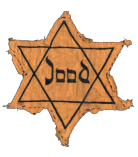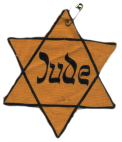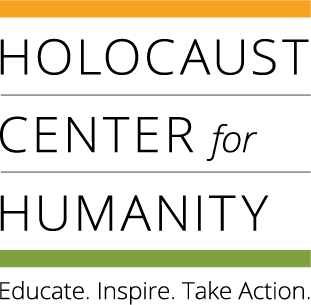Jewish Star
The Star of David was a Jewish symbol co-opted by the Nazis as a means of easily identifying and isolating Jews across Nazi-occupied Europe during the Holocaust. In many places, the Nazis required Jews to wear a Star as a badge, armband, or even in button form. The consequences for not doing so were severe.
The original bolt of fabric pictured above was four feet wide and six feet long. It was most likely made sometime in 1942 in Poland. Thomas Blatt, a survivor of the death camp Sobibor, found this fabric in Poland on a return trip in the 1980s and brought it back to the United States for conservation. In some places, Jews were actually forced to use their own money to purchase fabric or stars and sew them onto their own clothing.
Yellow stars were used by the Nazis to identify Jews in France, Belgium, Holland, Germany, Czechoslovakia, parts of Poland, parts of Bulgaria, Hungary, Greece, Lithuania, Latvia, and Romania. White armbands with a blue star of David were used to identify Jews in parts of Poland. Yellow armbands were used to identify Jews in parts of Greece and Yugoslavia.
Below are several memories from Seattle-area Holocaust survivors regarding their experience being forced to wear identification marking them as a Jew.
Noemi Ban, Hungary. From her memoir Sharing is Healing:
“Members of the Arrow Cross [Hungarian Nazis] came to our house… They told us that in a few days large posters would be glued onto the walls outside the houses. We had to read and obey them. On them were the ‘Jewish Laws.’
The first law told us to wear the yellow star. We had to wear it whenever we went outside. Where should we get those yellow stars? The Arrow Cross told us. We had to march to the store. Soldiers were all around us. We had to use our own money to buy yellow stars. We had to sew one onto each piece of clothing we had on. Imagine how embarrassed we were… We knew in our hearts that something much more terrible would soon come.”
***
Henry Friedman, Poland. From a Holocaust Center for Humanity video:
“One time my mother and my cousin got caught not wearing the armband. The reason you didn’t want to wear them was because anybody could throw rocks at you or hit you… Nobody was out to protect the Jew. So if people went to an area where they were afraid to walk with the armband, they might take it off.
Well, the police did catch my mother and my cousin not wearing it. My mother they beat with a ball, a rubber ball, but inside was a piece of steel and her arms were beaten up…all swollen. My cousin was about seventeen years old; they made her clean an outhouse with her hands.”



^This star was worn by an unknown prisoner in the Lodz Ghetto in Poland.
^Jood—Dutch for “Jew.” This star was worn by Elli Metzelaar, the mother of local Holocaust survivor, Peter Metzelaar, and is on display at the Holocaust Center for Humanity.
^This “J” stands for Jood in Flemish and Juif in French, the two languages spoken in Belgium. This star was worn by Martha Schnabel-Bloch, grandmother of local Holocaust survivor Robert Herschkowitz.

